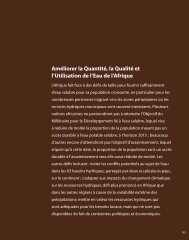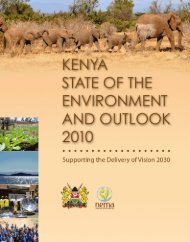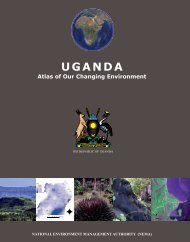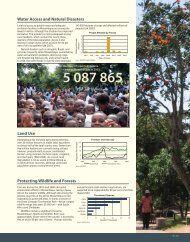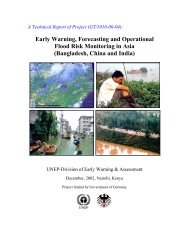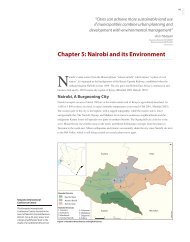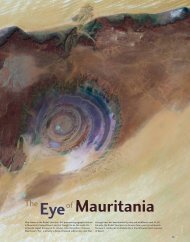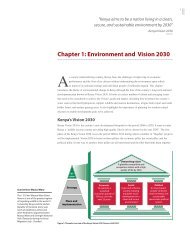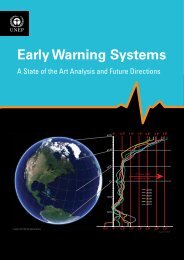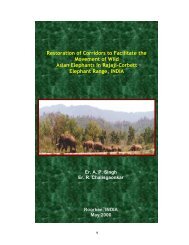Problèmes environnementaux majeurs - UNEP/GRID-Sioux Falls
Problèmes environnementaux majeurs - UNEP/GRID-Sioux Falls
Problèmes environnementaux majeurs - UNEP/GRID-Sioux Falls
Create successful ePaper yourself
Turn your PDF publications into a flip-book with our unique Google optimized e-Paper software.
364 <br />
Aaron, K.K. (2004). Perspective: Big Oil, Rural Poverty, and Environmental Degradation in the Niger<br />
Delta Region of Nigeria. Journal of Agricultural Safety and Health 11(2):127-134.<br />
Fentiman, A. (1996). The anthropology of oil: the impact of the oil industry on a fi shing community in<br />
the Niger Delta. Social Justice 23(4):1043-1578<br />
Ologunorisa, T.E. (2001). A review of the effects of gas fl aring on the Niger Delta environment.<br />
Interna¬tional Journal of Sustainable Development and World Ecology 8:249-255.<br />
Peterside, S. and Ogon, P. (n.d.) Background Paper, The Niger Delta. Green Governance<br />
Project: Insti¬tute of International Studies; UC Berkeley. http://globetrotter.berkeley.edu/<br />
GreenGovernance/pa¬pers/ (Dernier accès le Février 5, 2007)<br />
<strong>UNEP</strong> (2006). Niger Delta Human Development Report. United Nations Development Programme,<br />
Garki, Abuja, Nigeria. http://hdr.UNPD.org/reports/detail_reports.cfm?view=1060 (Dernier accès<br />
le Janvier 20, 2007)<br />
WWF (2001) .Ecoregion Profi le – Central African mangroves (AT1401) http://www.worldwildlife.org/<br />
wildworld/ profi les/terrestrial/ at/ at1401 _full.html (Dernier accès le Juin 13, 2007)<br />
Landsat-5 MSS, 13 Décembre 1984, bands 2, 4 and 1<br />
Landsat-7 ETM+, 08 Janvier 2003, bands 7, 4 and 2<br />
RWANDA<br />
CBD (2003). Convention on Biological Diversity. Rwanda Ministry of Lands, Resettlement and<br />
Environ¬ment. National Strategy and Action Plan for the Conservation of Biodiversity in Rwanda.<br />
http:/ / www. cbd.int/ doc/world/ rw/ rw-nbsap-01-en.pdf (Dernier accès le Janvier 9, 2008)<br />
EarthTrends (2006). Calculation using population data from Population Division of the Department of<br />
Economic and Social Affairs of the United Nations Secretariat, 2005. World Population Prospects:<br />
The 2004 Revision.<br />
FAO (2005a). FAO STAT statistical databases. http://faostat.fao.org/default.aspx (Dernier accès le<br />
Janvier 18, 2008)<br />
FAO (2005b). Irrigation in Africa fi gures – AQUASTAT Survey 2005. http://www.fao.org/nr/water/<br />
aquastat/ countries/ rwanda/ rwanda_cp.pdf (Dernier accès le Janvier 9, 2008)<br />
FAO AGL (2003). Land Degradation Severity. Terrastat online database. http://www.fao.org/ag/agl/<br />
agll/ terrastat/ #terrastatdb (Dernier accès le Janvier 9, 2008)<br />
Rwanda Nyungwe Forest (2007). Nyungwe Forest. http://www.rwanda-nyungwe-forest.com/ (Dernier<br />
accès le Février 6, 2008)<br />
UN (2007). Indicateurs des Objectifs du Millénaire pour le Développement. http://mdgs.un.org/unsd/<br />
mdg/Default.aspx (Dernier accès le Janvier 9, 2008)<br />
<strong>UNEP</strong> (2006). GEO Data Portal. http://geodata.grid.<strong>UNEP</strong>.ch/ (Dernier accès le Février 6, 2008)<br />
UNESA (2006). Population Division of the Department of Economic and Social Affairs. World<br />
Urbaniza¬tion Prospects: The 2005 Revision. Dataset on CD-ROM. New York.<br />
USAID (2004). Rwanda Food Security Update Septembre 2004. http :/ / www.fews.net/ centers/<br />
innerSec¬tions.aspx?f=rw&m=1 001 386&pageID=monthliesDoc (Dernier accès le Janvier 9, 2008)<br />
WCS (2007). World Conservation Society. Nyungwe National Park. http://www.wcs.org/international/<br />
Africa/ rwanda/ nyungwe (Dernier accès le Janvier 9, 2008)<br />
Cicatrice de feu autour du parc national d’ Akagera<br />
FAO (2006). Global Forest Resources Assessment 2005 – Report on fi res in the Sub-Saharan Africa<br />
(SSA) Region. Fire Management Working Paper 9. www.fao.org/forestry/site/fi re-alerts/en<br />
(Dernier accès le Janvier 9, 2008)<br />
IRIN (2004). Fire Destroys one-third of Kagera National Park. IRIN News. http://www.irinnews.org/<br />
report.asp?ReportID=42062&SelectRegion=Great_Lakes&SelectCountry=RWANDA (Dernier accès le<br />
Décembre 14, 2006)<br />
Kanyamibwa, S. (1998). Impact of war on conservation: Rwandan environment and wildlife in agony.<br />
Biodiversity and Conservation 7:1399-1406<br />
Vande Weghe, J.P. (1990). Akagera, land of water, grass and fi re. WWF-Belgium, Brussels, Belgium.<br />
USAID. (2003). Rwanda Environmental Threats and Opportunities Assessment – Task Order No.<br />
818 under the Biodiversity & Sustainable Forestry IQC USAID Contract No. LAG-I-00-99-00014-00<br />
Submitted by: Chemonics International Inc., Février 2003.<br />
Landsat-3 MSS, 20 Aout 1980, bands 2, 4 and 1<br />
Landsat-5 TM, 20 Juin 1984, bands 7, 4 and 2<br />
Landsat-7 ETM+, 31 Décembre 1999, bands 7, 4 and 2<br />
Landsat-7 ETM+, 21 Juillet 2004, bands 7, 4 and 2<br />
Déforestation de la forêt de Gishwati<br />
Jones, N. (2003). Chock-Full of Methane, Lake Kivu Stores Enough Energy to Power all of Rwanda. New<br />
Scientist, 177(2384), pp. 17<br />
Hansen, B. (2006). Engineers Remove Methane from Africa Lake. Civil Engineering News:<br />
Environmen¬tal Engineering, American Society of Civil Engineers 08857024.<br />
MLEFWM – Ministry of Lands, Environment, Forestry, Water and Mines, Republic of Rwanda. (2005).<br />
Initial National Communication under the United Nations Framework Convention on Climate<br />
Change [online]. Available from: http:/ / unfccc.int/ resource/ docs/ natc/ rwanc1 .pdf (Dernier<br />
accès le Décembre 4, 2006)<br />
RDG – Rwanda Development Gateway. (2005). Environmental Activities in Rwanda: Afforestation<br />
[online]. Available from: http://www.rwandagateway.org/article.php3?id_article=92 Dernier accès:<br />
4th Décembre 2006<br />
WAC - World Agroforestry Centre. (2003). Agroforestry Checks the Devastating Loss of Land on<br />
Rwanda’s Thousand Hills. http://www.worldagroforestrycentre.org/ar2003/downloads/2pager_LP_<br />
Web002.pdf (Dernier accès le Décembre 5, 2006)<br />
ASTER-VNIR, 16 Juin and 03 Novembre 2006, bands 2, 3, and 1<br />
Landsat-2 MSS, 06 Février 1978, bands 2, 4 and 1<br />
SÃO TOMÉ ET PRÍNCIPE<br />
EarthTrends (2006). Calculation using population data from: Population Division of the Department<br />
of Economic and Social Affairs of the United Nations Secretariat, 2005. World Population Prospects:<br />
The 2004 Revision. Dataset on CD-ROM. New York. http://www.un.org/esa/population/ordering.<br />
htm (Dernier accès le Janvier 9, 2008)<br />
Encyclopedia of the Nations (2007). Africa. São Tomé and Príncipe. Environment. http:/ / www.<br />
nation¬sencyclopedia.com/Africa/S-o-Tom-and-Pr-ncipe-ENVIRONMENT.html (Dernier accès le<br />
Février 6, 2008)<br />
FAO (2000). Forestry Division. Global Forest Resources Assessment 2000. http://www.fao.org/do¬crep/<br />
004/ y1997e/ y1997e0n.htm (Dernier accès le Janvier 9, 2008)<br />
FAO (2007). FAO STAT statistical databases. http://faostat.fao.org/default.aspx (Dernier accès le<br />
Janvier 18, 2008)<br />
IUCN (2007). Summary Statistics for Globally Threatened Species. Table 5. http:/ / www.iucnredlist.<br />
org/info/stats (Dernier accès le Janvier 25, 2008)<br />
MONGABAY.COM (2007). Tropical Rainforests. SAO TOME AND PRINCIPE. http:/ / rainforests.<br />
mong¬abay.com/20saotome.htm (Dernier accès le Février 6, 2008)<br />
Développement urbain de l’île de Sao Tomé<br />
MDGR (2004).Sao Tome & Principe. http://www.UNPD.org/energyandenvironment/<br />
sustainablediffer¬ence/ PDFs/ Africa/ SaoTomeandPrincipe.pdf (Dernier accès le Janvier 9, 2008)<br />
UNDG (1998). São Tomé and Príncipe: Common Country Assessment. http://www.undg.org/archive_<br />
docs/ 1 687-Sao _Tome ___Principe _CCA_-_Sao _Tome ___Principe_1 998.pdf<br />
International Monetary Funds (2005). http://imf.org/external/pubs/ft/scr/2005/cr05334.pdf<br />
(Dernier accès le Janvier 9, 2008)<br />
DigitalGlobe-Quickbird, 17 Juin 2007, bands 3, 2 and 1<br />
SENEGAL<br />
FAO (2005). Irrigation in Africa fi gures – AQUASTAT Survey 2005. http://www.fao.org/nr/water/<br />
aqua¬stat/ countries/ senegal/ senegal_cp.pdf. (Dernier accès le Janvier 9, 2008)<br />
FAO (2000-2007). Fisheries and Aquaculture Department. Senegal Fisheries and Aquaculture Country<br />
Profi le. http://www.fao.org/fi / website/ FISearch.do?dom=country (Dernier accès le Janvier 9, 2008)<br />
UNESA (2006). Population Division of the Department of Economic and Social Affairs. World Urbaniza<br />
tion Prospects: The 2005 Revision. Dataset on CD-ROM. New York.<br />
Trade Measures in CITES (2000). IUCN Report. http://www.cites.org/common/prog/economics/iucn<br />
¬trademeasuresinCITES.pdf (Dernier accès le Février 6, 2008)<br />
<strong>UNEP</strong> (2002). Africa Environment Outlook. Past, present and future perspective. Nairobi.<br />
UN (2007a). Indicateurs des Objectifs du Millénaire pour le Développement. http://mdgs.un.org/<br />
unsd/mdg/Default.aspx. (Dernier accès le Janvier 9, 2008)<br />
UN (2007b). World Statistics Pocketbook. United Nations Statistics Division. Department of Economics<br />
and Social Affairs, New York.<br />
Urbanization de la peninsula du Cap-Vert<br />
Dubresson, A. (1983). Regions. In: Pelissier, P. and Laclavere, G. (eds) Atlas du Senegal. Les Editions<br />
Jeune Afrique, Paris.<br />
Gueye, C., Fall, A.S.,Tall, S.M. (2007). Climatic perturbation and urbanization in Senegal. The<br />
Geo¬graphical Journal 173:88-92.<br />
Pison, G, Hill, K.H,, Cohen, B., Foote, K.A. (1995). Population dynamics of Senegal. National Academy<br />
Press, Washington, DC<br />
Mbaye, A. and Moustier, P. (2000). Market-Oriented Urban Agricultural Production in Dakar. In:<br />
Bak¬ker, N., Dubbeling, M., Gundel, S., Sabel-Koschella, U., Zeeuw, H.D. (eds) Growing Cities,<br />
Growing Food. Urban Agriculture on the Policy Agenda, A Reader on Urban Agriculture, SDE/ ZEL,<br />
Feldaf¬ing, p235-56<br />
UN Population Division. (2006). Population, Resources, Environment and Development: The 2005<br />
Revi¬sion. http://unstats.un.org/pop/dVariables/DRetrieval.aspx (Dernier accès le Novembre 19,<br />
2007) Aerial photograph mosaic, 1942 (Gray Tappan, EROS Data Center)<br />
DigitalGlobe-Quickbird, 21 Décembre 2006 and 26 Mars 2007, bands 3, 2 and 1<br />
Perte de forêts à Leboudou Doue<br />
Black, R. and Sessay, M.F. (1997a). Forced migration, environmental change and woodfuel issues in the<br />
Senegal River Valley, Environmental Conservation 24:251-260.<br />
Black, R. and Sessay, M.F. (1997b). Refugees, land cover, and environmental change in the Senegal River<br />
Valley. GeoJournal 41(1): 55-67.<br />
Horowitz, M.M. and Salem-Murdock, M. (1993). Developmnet-Induced Food Insecurity in the Middle<br />
Senegal Valley. GeoJournal 30(2): 179-184.<br />
IUCN (n.d.). The Senegal River: Resease of an Artifi cal Flood to Maintain Traditional Floodplain<br />
Productions Systems. http://www.iucn.org/themes/wani/fl ow/cases/ Senegal.pdf (Dernier accès le<br />
Novembre 26, 2007)<br />
Rasmussen, K. Larsen, N. Planchon, F. Andersen, J. Sandholt, I. And Christiansen, S. (1999).<br />
Agricul¬tural systems and transnational water management in the Senegal River basin. Danish<br />
Journal of Geography 99: 59-68<br />
Tappan, G.G., Sall, M. Wood, E.C. and Cushing, M. (2004). Ecoregions and land cover trends in<br />
Sen¬egal. Journal of Arid Environments 59(3): 427-462.<br />
Corona, 26 Décembre 1996<br />
DigitalGlobe-Quickbird, 08 Mars 2006, bands 3, 2 and 1<br />
SEYCHELLES<br />
Wilkie, M., L. and Fortuna, S. (2003). Status and Trends in Mangrove Area Extent Worldwide. FAO<br />
Forestry Department. http://www.fao.org/docrep/007/j1533e/J1533E32.htm (Dernier accès le<br />
Janvier 9, 2008)<br />
UN (2007). World Statistics Pocketbook. United Nations Statistics Division. Department of Economics<br />
and Social Affairs, New York.<br />
<strong>UNEP</strong> (2006). Africa Environment Outlook 2: our environment, our wealth. Nairobi, Kenya. <strong>UNEP</strong>-<br />
WCMC (2001). World Atlas of Coral Reefs. http://www.<strong>UNEP</strong>-wcmc.org/marine/coralatlas/in¬dex.<br />
htm (Dernier accès le Janvier 9, 2008)<br />
UNESCO (2007). Alabro Atoll. World Heritage List. http://whc.unesco.org/en/list/185 (Dernier accès<br />
le Janvier 9, 2008)<br />
Réclamation de terres sur l’île de Mahé<br />
GEF (2007). Status of the Marine Environment Report – Seychelles, Septembre 2007. Compiled by<br />
Bijoux, J.P., Decomarmond, A. and Aumeeruddy, R.<br />
Prosper, J. P. N. (2007). Personal Communication with Mr. Justin Paul Nicholas Prosper, Senior GIS<br />
Of¬fi cer, Department of Environment, Victoria, Mahe, Seychelles.<br />
Aerial photograph mosaic (courtesy of Department of Environment, Seychelles) DigitalGlobe-<br />
Quickbird, 13 Décembre Septembre 2007, bands 3, 2 and 1<br />
SIERRA LEONE<br />
FAO (2007). Land and Water Development Division. AQUASTAT Information System on Water and<br />
Agriculture: Online database. http://www.fao.org/nr/water/aquastat/data/query/index.html<br />
(Dernier accès le Janvier 9, 2008)<br />
Blinker, L. (2006). Country Environment Profi le: Sierra Leone. United Kindgom: Consortium Parsons<br />
Brickerhoff. http://www.delsle.ec.europa.eu/en/whatsnew/Docs/Final%20Report%20Country%20<br />
Environmental%20Profi le%20(CEP) %20SL%201 9-O CT-06.pdf (Dernier accès le Janvier 9, 2008)<br />
CBD (n.d.). Convention on Biological Diversity. Republic of Sierra Leone. National Biodiversity Strategy<br />
and Action Plan. http:/ / www.cbd.int/ countries/ profi le.shtml?country=sl#status (Dernier accès le<br />
Janvier 9, 2008)<br />
UNCCD (2004). National Report on the Implementation of the United Nations Convention to Combat<br />
Desertifi cation. Sierra Leone http:/ / www.unccd.int/ cop/ reports/ africa/national/ 2004/<br />
sierra_le¬one-eng.pdf (Dernier accès le Janvier 9, 2008)<br />
<strong>UNEP</strong> (2006). GEO Data Portal. http://geodata.grid.<strong>UNEP</strong>.ch/ (Dernier accès le Février 6, 2008)<br />
USGS (2007). 2005 Minerals Yearbook. Sierra Leone. http://minerals.usgs.gov/minerals/pubs/<br />
coun¬try/ 2005/ slmyb05.pdf (Dernier accès le Février 6, 2008)<br />
Exploitation du Rutile, District de Moyamba<br />
Africa Development Bank (ADB). (2005). Sierra Leone 2005-2009 Country Strategy Paper, Juillet<br />
2005. Brima, A. A. (2004). Development Diamonds-Sierra Leone: Environment, Development and<br />
Sustainable<br />
Peace, Finding Paths to Environmental Peacemaking, Wilton Park Conference-London 16th-19th<br />
Septembre 2004.<br />
Deen, A. M. S. (2003). Mineral Resources Wealth for Sustainable Economic Growth. Extractive<br />
Industries Transparency Initiative (eiti), London Conference, 17 Juin 2003. http:/ / www2.dfi d.gov.<br />
uk/ pubs/ fi les/ eitidraftreportsleone.pdf (Dernier accès le Janvier 25, 2008)<br />
DACO/ SLIS (2004). Moyamba District 3rd Data Pack. http://www.daco-sl.org/encyclopedia/3_dist/3_<br />
1i_mo.htm (Dernier accès le Janvier 25, 2008)<br />
Friends of the Earth (1997). Mined Out: The Envionmental and Social Implications of Development<br />
Fi¬nance to Rutile Mining in Sierra Leone. Friends of the Earth, England Wales and Northern



